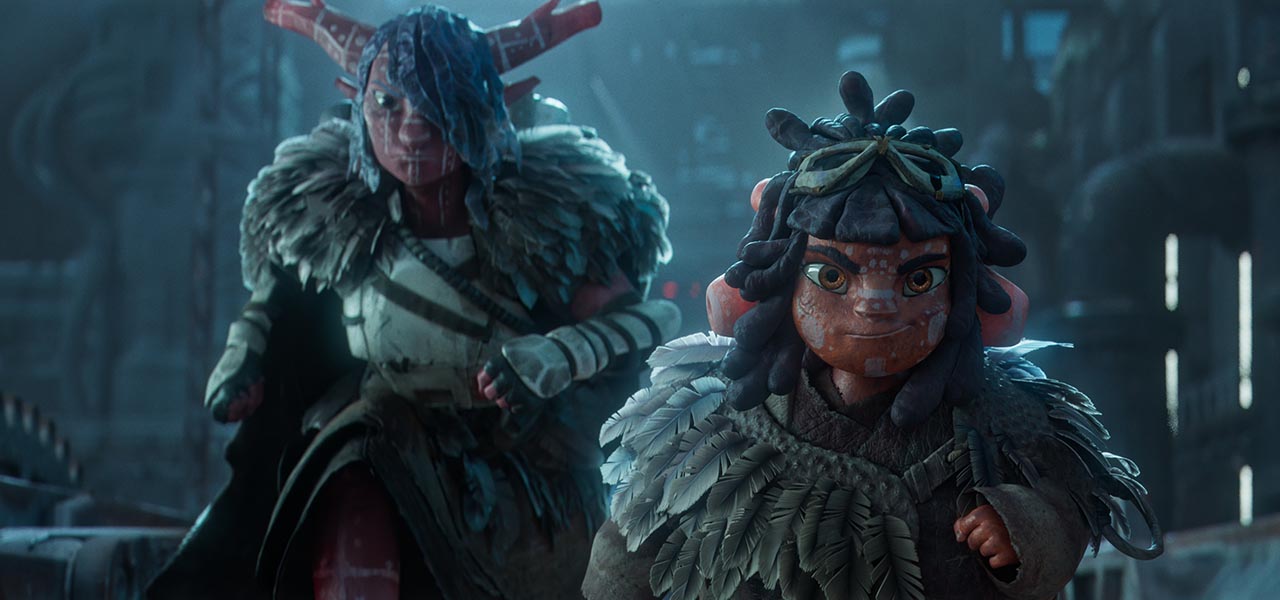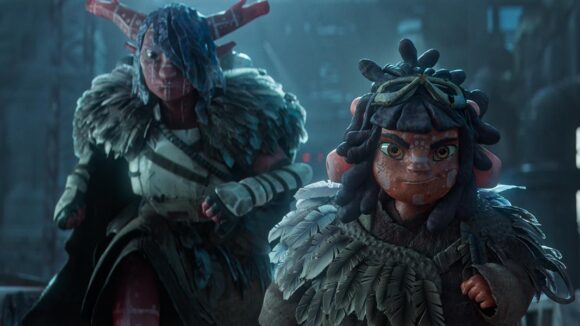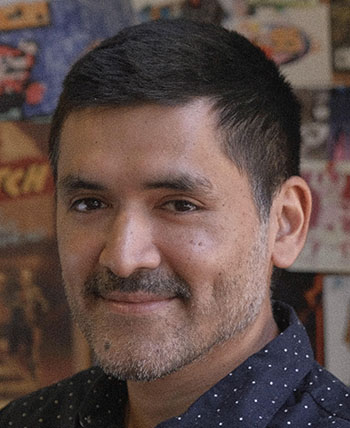

2025 Oscars Short Film Contenders: ‘In The Stars’ Director Gabriel Osorio Vargas
Cartoon Brew is putting the spotlight on animated short films that have qualified for the 2025 Oscars.
In this installment, we’re looking at In The Stars from Chilean filmmaker Gabriel Osorio Vargas and is part of the Star Wars: Vision second season. The short earned its Oscars qualification by winning the best animated short at Lebu International Film Festival.
In this intergalactic yet grounded and intimate story, two sisters, the last of their kind who live in hiding on their ravaged land, squabble about how to survive with the Empire encroaching. On a water run, the sisters must fight back when they are discovered. The short is co-produced by Santiago, Chile-based Punkrobot Studio and Lucasfilm.
Cartoon Brew: Your Star Wars story is grounded in the very real story of the Patagonian Selk’nam people, who were the victim of a genocide at the turn of the 20th century. What were the challenges in making this story universal and fit the Star Wars canon while staying true to the actual events?

Gabriel Osorio Vargas: The universe of Star Wars contains a theme of colonization that has always deeply resonated with me. My childhood as a Chilean and a Latin American is filled with memories and stories of empires and heroes who colonized this land, yet the past of the people who inhabited this place before colonization was erased. This parallel between the fictional empire of Star Wars and the colonization of Latin America has been an image that has stayed with me since I first saw the original trilogy as a child.
As a Latin American, it was crucial for me to establish that the sisters in the story live in a place far removed from what is understood as the “center of the galaxy.” For example, while writing, I was tempted to include a classic Jedi, lightsaber and all, but as I tried to draw parallels with the Selk’nam people, I realized that the inhabitants of this planet wouldn’t even know what a Jedi was. They wouldn’t have the same name for “the force.” That’s part of the “Western” culture within the Star Wars universe, so to speak. Just as the Kawésqar people didn’t have a word for the concept of “police,” the inhabitants of this distant world wouldn’t have knowledge of Jedi or their culture.
This kind of parallel led me to remove several iconic elements of the Star Wars imagery while maintaining an honesty to our characters and their culture, distinct from that of the imperial colonizers. Instead of holograms, there are drawings on stone; instead of lightsabers, there are canoes; and instead of Force ghosts, there are stars.
What was it about this story or concept that connected with you and compelled you to direct the film?
In the Stars is inspired by the colonization of the Patagonian people, in what is now Chile and Argentina. Because it is such a remote region, colonization by European settlers didn’t start until the end of the 19th century and the beginning of the 20th. The Selk’nam, Kawésqar, and Aónikenk people faced a delayed and brutal colonization. They were hunted and enslaved by settlers, displayed in “human zoos” and decimated by Western diseases. This genocide continued to occur well into the 1900s, less than 100 years ago.
Because it is part of a relatively recent history, it was scarcely discussed during my childhood in the 1990s. Many of my generation grew up thinking that the Patagonian people were simply “savages” who had gone extinct long ago due to natural causes. We were never taught about the atrocities they faced. As a child, more than once, people insulted me because of my skin color by calling me “Alacalufe,” a derogatory term meaning ignorant, uncivilized, or dumb. Much later, I discovered that this name was imposed by settlers on the Kawésqar people. I also learned that this community was not only not extinct, but possessed a rich cultural heritage that was erased. They faced injustice and discrimination, and their people’s name was turned into a synonym for shame.
In the Stars was born as a way for us, as Chileans, Argentinians, and Latin Americans, to look back at the history of the land we inhabit — our tragic past — and view it from a different perspective. My intention is to open the door to conversations about our past, to confront the mistakes made by our countries, and to transform what was once shame and tragedy into hope, pride, and dignity. Today more than ever, it is the responsibility of our states to repair and go forward as an inclusive nation. I like to think that, as filmmakers, the stories we tell can help shape the reality we live in.
This is why In the Stars touches on themes of injustice and loneliness — sisters who lost everything: their people, their culture, their land, and their mother due to the injustice of brutal colonization. Stories like this, and like my previous short Bear Story, have always drawn me because of their darkness and tragedy. To look into the darkness in an attempt to find the light that might exist there. And what amazes me most is realizing that those answers are found precisely in the worldview of the Patagonian people, where the light of the stars is the light that connects us with our ancestors and our missing loved ones.
What did you learn through the experience of making this film, either production-wise, filmmaking-wise, creatively, or about the subject matter?
As I started writing the script, I relied on books by authors like José Luis Alonso Marchante, which helped me gain a broader perspective on our history. Similarly, documentaries by Patricio Guzmán, such as The Pearl Button, were a direct source of inspiration for the story.
In addition, our team took a trip to Karukinka, one of the southernmost places in the world, located on the island of Tierra del Fuego. There, we had the opportunity to experience the landscape and the places inhabited by the original nations, which directly influenced both the script and the visual style of the short film. We 3d-scanned trees, rocks, and shells, which were later transformed into visual elements that faithfully capture the atmosphere of Patagonia. During this journey we also discovered the hand paintings left on a massive stone wall by the Aónikenk people, a basic and raw form of art and expression, yet overwhelmingly beautiful, in what is called “Wall of hands of Cerro Castillo”. These paintings later inspired one of my favorite sequences in the short film, when Tichina tells the story of their mother through rock paintings.
One of the things I realized after making the short film is that many Chileans still don’t know the real history of the south of our country. In that sense, I hope that In the Stars serves as an entry point for new generations to engage in a conversation about a dark chapter in our history — one that is essential to confront.
Can you describe how you developed your visual approach to the film? Why did you settle on this style/technique?
In the Stars is a blend of real, handcrafted models scanned in 3d and cgi characters and environments. From the very beginning, it was important to me to represent a detailed yet imperfect, handmade world. The story takes place on a distant, forgotten planet, almost forgotten by the Empire. For me, this imperfection is an essential part of my Latin American identity. Our work is artisanal, handmade — it’s not perfect or polished. On the contrary, it’s raw material of immense beauty. The character design was heavily influenced by the body art and paintings of the Selk’nam people — a unique art form of incredible creativity. Of course, all the designs are inspired by, rather than literal copies of, their work, as each dot and line holds cosmological significance that we felt was important to respect.
The animation was crafted in the same spirit, intentionally removing frames to focus on the essential, on each character’s pose, without letting the computer automatically interpolate; every pose is a human-driven decision. It was important to me that the short film and the characters felt human. This idea shaped all the art and techniques we developed for the short film.
This interview has been edited for length.

.png)